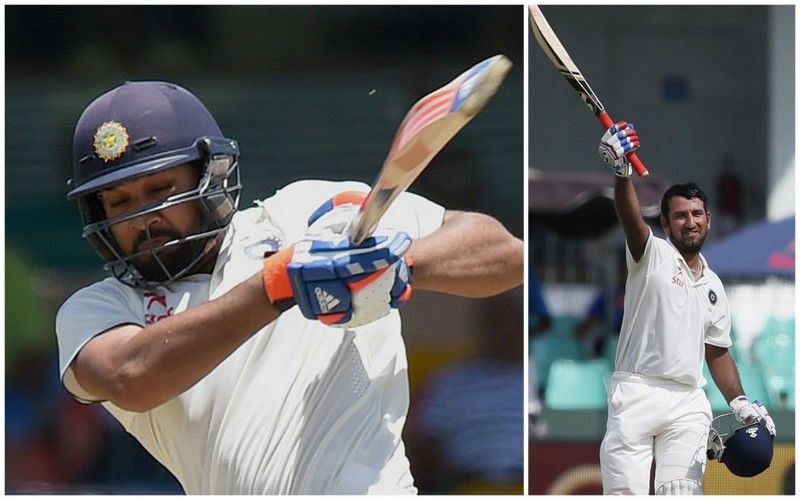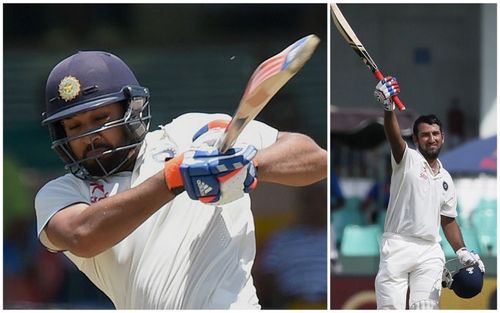
Cheteshwar Pujara vs Rohit Sharma: All batsmen are equal, some more equal than others

In cricket, one is as good as somebody else’s opinion. In Indian cricket, one’s intrinsic worth is effectively gauged by interest groups and lobbyists. While perceptions indubitably play their part, Indian cricket is psychotically obsessed with the idea. So, it is impossible not to be swayed by Yuvraj’s prophecy about potential 10000 Test runs, howsoever fallacious the assumption might be.
While it may seem unjust, to take this up on a day which belonged exclusively to Cheteshwar Pujara, who quelled any doubts about a place in the side, his story is unfortunately intertwined with that of Rohit Sharma.
Has the maxim, Temperament rather than talent separates men from the boys at the highest level, ever been more apt? Perhaps the gross overuse of the term talent while referring to a chronically underperforming Rohit, demands a rethink. Of course, sceptics rejoiced in the good karma playing itself out at the Sinhalese Sports Club. India were hobbling at 64 for three, when fate intervened in the form of retribution.
A persevering Pujara was joined by a privileged Rohit. The stage was set. There was an obvious subtext to the drama played out by India and Sri Lanka. The desperation to validate Rohit’s numerous forays into the Test side had kept India’s best number three warming the bench for the last four Tests.
While the duo battled the combination of an uncharacteristically spicy pitch and a sprightly Dhammika Prasad, the underlying tension for one spot dominated proceedings in the minds of the cricket buff. What transpired restored one’s faith in cricket and in all humanity. Pujara scored a chanceless hundred on return to Test cricket, while Rohit elegantly edged a quotidian fifth stump length ball, to first slip. Furthermore, Pujara didn’t even bat in his customary number three position, which has been part of a virtual merry-go-round since Rohit was elevated to the spot.
With hundreds from Shikhar Dhawan, KL Rahul and Pujara, India has unearthed a problem of plenty in Sri Lanka but the nagging problem of Rohit has negated the advantage. On the back of a career-reviving ton, Pujara should be reinstated at number three, allowing Rahane to drop down to five. India’s predilection to play an all-rounder at six leaves two vacant spots, for Vijay, Dhawan and Rahul. And no place for Rohit.
All batsmen are equal, some are more equal than others
Their story has its genesis in the year 2014. Successive tours of South Africa, New Zealand, England and Australia promised a stomach-churning ordeal. The air of Romance and Reminiscence was contagious. Inevitable parallels were drawn between the team under Ganguly in 2002 and the young one preparing to globe trot under Dhoni. It was a year of reckoning for India’s nascent batting brigade.
Prior to India’s first Test at Johannesburg, there was excitable tension, tempered with voices of caution. In Indian cricket however, expectations can suddenly spurt like an unbridled helium balloon. What transpired in Johannesburg provided a hazy glimpse into a balmy future. Pujara’s innings of 152 justified comparisons with Rahul Dravid, who incidentally scored his first Test hundred at the same ground. It was Pujara’s sixth. Two of those were doubles.
India flattered to deceive though, as the bowlers lost steam in the second innings, allowing South Africa to secure a comfortable draw. It set a template for what followed. The next three Tests in South Africa and New Zealand were laden with myriad lost opportunities. Pujara lost form in New Zealand, but there was no imminent threat to his place.
Rohit was slipping down the pecking order, or so it seemed. He was flirting with an axe, looming precariously over his head, or so it seemed. He oscillated between a dreamy languor and impetuousness. An average of 23.85 fell pale in comparison to his teammates, all of whom had impressed thus far.
The team itself was still learning the art of closing out matches away from home. In fact they had begun stitching India’s pride, which had been in tatters since ignominious whitewashes in England and Australia.
So, India commenced their English sojourn brimming with confidence. This was Dhoni’s best shot at redemption. England looked vulnerable and nowhere in the league as South Africa and New Zealand. Two tests into the series expectations sky rocketed. India defeated archetypal English conditions at Lord’s to take a one-nil lead in the five-Test series. The inexorable pull of overseas defeats was stemmed where it had originated in 2011. Life had come a proverbial full circle. Except a minor irritant, that Kohli and Pujara were yet to fire on all cylinders.
Pujara developed an uncharacteristic penchant for throwing away starts. Although a gritty 28 in trying conditions at Lord’s was like gold dust. India had won. Now, imagine what could be achieved if and when, the lynchpins of the batting line-up found their moorings in England. The wait soon turned into a painful yearning.
Against the water currents, two successive losses followed at Southampton and Old Trafford. Suddenly, there was a paucity of time, Pujara’s walls were closing in on him. India had fallen deep down a familiar ditch of defeat. The tipping point was a moment of madness at Southampton. In the line of fire stood who else, but India’s blued eyed boy; Rohit Sharma. In adversity was his opportunity to silence the doubting Thomases, who hoped against hope to be surprised.
Living to tell the tale
It was a mystifying selection in the first place, considering India were in the ascendency and Binny had already played a knock of substance. Dhoni’s One-Day habits came to the fore at an inopportune hour. Combined with Rohit’s T20 habits, it was a disastrous concoction. Rohit displayed immense patience en route a 61-ball 28 before an inexplicable urge to play an aerial shot, four balls before tea, cost India his wicket.
His imbecility was unforgivable. His fate as a Test cricketer should have been sealed with that atrocious shot at the stroke of tea. He lacked moral fibre, it was clear as an unmuddied lake. But Rohit would play again. Rohit would disappoint again, and the vicious cycle would unabatingly repeat itself.
India resorted to the seven-four combination in Australia. Having proved his worth in South Africa, Pujara held his number three spot, at least to begin with. Rohit benefitted from blind faith. A feeling of déjà vu followed Pujara like malevolent force through the course of the Australian tour. There was a discernible desperation to feel bat on ball with every passing innings. His arid run stubbornly refused to subside. He found alien ways to get out. He chased deliveries that even Rohit left alone.
Pujara was failing, India were losing, the series was eventually lost in Melbourne. One could feel for him though. He had begun well again. A fluent 73 in the first innings at Adelaide was an encouraging sign, but not ominous. Pujara needed the psychological cushion of a hundred following his failures in England. It wasn’t to be. That was the best he could conjure.
Rohit was Rohit. In between a couple of chancy forties there was nothing that warranted selection. Except hundreds against a meek West Indies at home, Rohit did not have the safety net of past performances either. Judgement day had surely arrived for Rohit. A contribution of note in the second innings at Adelaide or the Brisbane Test could have turned the series on its head. India had lost, but they hadn’t been embarrassed. There were times when they were on top. There were times when they came back from behind. India had their chances, as did Rohit.
He was dropped at Melbourne. He was back in Sydney. The perks of being Rohit Sharma. The perks of a charmed life. What’s more, the obvious lack of temperament notwithstanding, the team management thought it prudent to promote him to the crucial number three position. A position to which, Rahul Dravid had propriety rights. A position he would hold for two subsequent Tests, against Bangadesh and Sri Lanka.
It was an outrage, an absolute mockery of logic and common sense. A perpetually struggling Rohit, replaced a temporarily struggling Pujara. While, a break wasn’t the worst thing for India’s best long term number three solution, Rohit’s elevation struck a chord with the cricket gods. As is his wont, he scored an unconvincing fifty and a 39 just as the door was slamming on him. He lived to tell another disappointing tale.